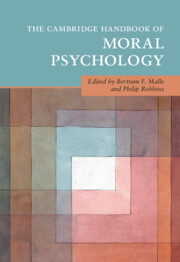Book contents
- The Cambridge Handbook of Moral Psychology
- Cambridge Handbooks in Psychology
- The Cambridge Handbook of Moral Psychology
- Copyright page
- Contents
- Figures
- Tables
- Contributors
- Preface
- 1 Modern Moral Psychology
- Part I Building Blocks
- 2 Moral Character
- 3 Moral Motivation
- 4 Norms: Inference and Interventions
- 5 Moral Dilemmas
- 6 The Moral Domain
- Part II Thinking and Feeling
- Part III Behavior
- Part IV Origins, Development, and Variation
- Part V Applications and Extensions
- Index
- References
5 - Moral Dilemmas
from Part I - Building Blocks
Published online by Cambridge University Press: 20 February 2025
- The Cambridge Handbook of Moral Psychology
- Cambridge Handbooks in Psychology
- The Cambridge Handbook of Moral Psychology
- Copyright page
- Contents
- Figures
- Tables
- Contributors
- Preface
- 1 Modern Moral Psychology
- Part I Building Blocks
- 2 Moral Character
- 3 Moral Motivation
- 4 Norms: Inference and Interventions
- 5 Moral Dilemmas
- 6 The Moral Domain
- Part II Thinking and Feeling
- Part III Behavior
- Part IV Origins, Development, and Variation
- Part V Applications and Extensions
- Index
- References
Summary
This chapter of the handbook tackles a frequently discussed topic in moral psychology: moral dilemmas. The authors offer a normative characterization of moral dilemmas as a situation in which every available course of action involves a difficult moral trade-off and it is morally appropriate for the agent to feel conflicted about the choices available. The authors then explore different empirical accounts of why some moral trade-offs are experienced as difficult or impossible to resolve. Among the most influential of these accounts is dual-process theory, which traces the experience of moral dilemmas to a conflict between a value backed by automatic emotional processes and a value backed by reflection. The authors argue against the dual-process account, and review empirical research bearing on the psychological mechanisms underpinning a person’s experience and resolution of moral dilemmas, as well as the phenomenon of “moral residue.” They argue that further empirical work is needed to understand how people weigh competing values against one another and that such understanding requires expanding the range of moral dilemmas to include cases beyond those targeted in recent research.
Keywords
- Type
- Chapter
- Information
- The Cambridge Handbook of Moral Psychology , pp. 101 - 123Publisher: Cambridge University PressPrint publication year: 2025

